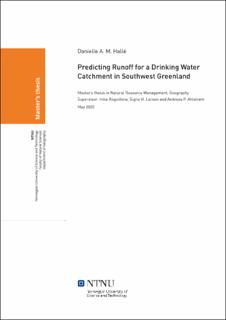| dc.contributor.advisor | Rogozhina, Irina | |
| dc.contributor.advisor | Larsen, Signe H. | |
| dc.contributor.advisor | Ahlstrøm, Andreas P. | |
| dc.contributor.author | Hallé, Danielle A. M. | |
| dc.date.accessioned | 2021-09-28T17:54:28Z | |
| dc.date.available | 2021-09-28T17:54:28Z | |
| dc.date.issued | 2020 | |
| dc.identifier | no.ntnu:inspera:56115049:34545811 | |
| dc.identifier.uri | https://hdl.handle.net/11250/2785192 | |
| dc.description.abstract | Efterhånden som smeltevandsafstrømningen fra Grønlands gletsjere og iskapper stiger, er der et øget behov for at kvantificere denne afstrømning, for at forbedre forståelsen og give et mere nøjagtigt estimat af bidraget til den globale havniveaustigning, ændringer i havstrømme på grund af en faldende saltkoncentration og potentialet for udnyttelse af naturressourcer.
12 % af verdens gletsjere og iskapper findes langs Grønlands periferi, hvor langt størstedelen
ligger i oplande med delvist isdække, uden målinger og vejrstationer til at
kunne beregne smeltevandsafstrømningen. Klimamodeller har derfor en nøglerolle i at simulere og estimere mængden af smeltevand i fremtiden. Generelle cirkulationsmodeller og regionale klimamodeller har for lav opløsning til at fange terrænvariationerne i oplande med delvist isdække og kan resultere unøjagtigheder ved beregning af smeltevandsafstrømninger
Denne undersøgelse fremhæver disse unøjagtigheder ved at præsentere styrker og svagheder
ved flere klimamodeller; undersøgelsen validerer regionale klimamodeller på lokal skala, for at opnå afstrømning af smeltevand i mindre afvandingsområder i Grønland. Statistisk nedskalering fra 11 km til 30 m blev anvendt som et værktøj til at forbedre opløsningen på lufttemperatur og nedbørsdata i oplande med delvist isdække. Den samlede månedlige afstrømning i et afvandingsområde, i Vestgrønland, blev forudsagt frem til 2060 ved hjælp af en positiv gradedagsmodel. Med en beregnet smeltevandsafstrømning, der topper i 2040, konkluderer denne undersøgelse, at mængden af smeltevand er tilstrækkelig til kommerciel udnyttelse i de næste 40 år. | |
| dc.description.abstract | As meltwater runoff increases from local glaciers and ice caps in Greenland, there is motivation to better quantify this runoff to improve the understanding and more accurately estimate its contribution to global sea level rise, dynamics of seawater freshening on ocean currents and gauging the potential for natural resource exploitation. Twelve percent of the world’s glaciers and ice caps are contained around the periphery of Greenland and the vast majority lies in partially glaciated basins that are ungauged and without weather stations, thereby, resulting in a gap of available data required to calculate meltwater runoff in these catchment areas. This then leaves climate models as the key method to simulate and predict the amount of future runoff produced. Currently, calculating meltwater discharge with coarse resolution general circulation models or even regional climate models, does not completely capture the intricacies of the terrain in a partially glaciated basin and can create large potential for error. This study highlights these errors by presenting the strengths and shortcomings of several global and regional climate models on local scales on glacier catchments, with the aim to predict runoff more accurately. This evaluation has shown that none of the climate models adequately captures either spatial or temporal variability in air temperature and meltwater production. Statistical downscaling of climate grids, from 11 kms to 30 m, was applied as a tool to better resolve air temperature and precipitation in partially glaciated basins but was unable to counteract inaccuracies leaking from climate models into local estimates. The total monthly runoff was predicted, out to 2060, using a positive degree day model that focused on one drinking water catchment in Southwest Greenland, with a discharged peak in 2040. The catchment is therefore assessed as being able to provide a continuous source of drinking water for export throughout the next 40 years. | |
| dc.language | | |
| dc.publisher | NTNU | |
| dc.title | Predicting Runoff for a Drinking Water Catchment in Southwest Greenland | |
| dc.type | Master thesis | |
